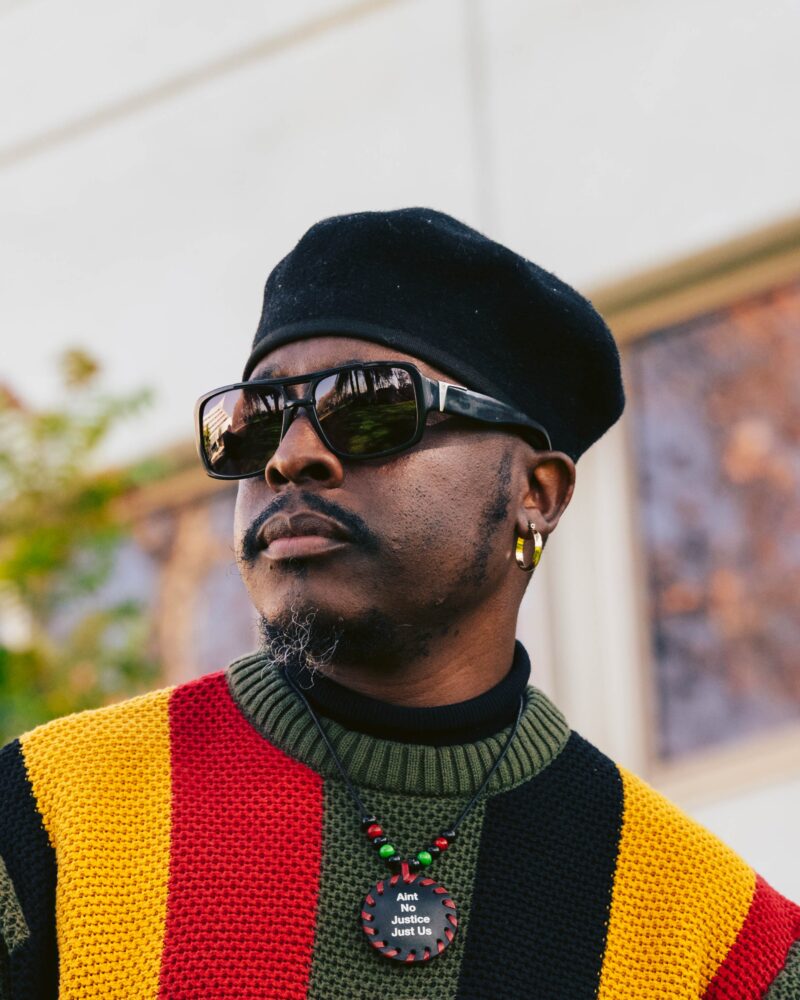
Graphic designers usually produce the visuals found on packaging, clothing, book covers, and transport vehicles. Yet, when their artistry is elevated to provoke thought, reflect society, or preserve cultural heritage, their creations achieve lasting significance.
Social commentary through digital design and artistry is what award-winning content creator, illustrator and graphic designer David Tshabalala knows well.
While he studied graphic design at the Central University of Technology in Bloemfontein, Tshabalala’s path was shaped during his early schooling years. His love for literature and drawing pictures gave him solace in being an above-average student who was one of the better artists in class.
After graduation, Tshabalala started his own branding and design company, Suketchi, with his former employer, Sarah-Jane Boden. He has worked with brands such as KFC, John Craig SA and The Courier Guy, among others. The turning point for Tshabalala in realising his work can have a social impact, came in 2014.
“That was a big year for me because I started to find my voice and unique style. So, I had an idea to host exhibitions,” he says.
He developed a series of exhibitions called Run The World. The exhibitions were inspired by women Tshabalala found inspiring.
“I grasped how to fuse my digital art and social media. I learned how to connect with people. So, for each day on Women’s Month; I illustrated portraits of women who inspire me on Instagram and I profiled who they are and what they do,” he adds.
Tshabalala has also done work inspired by some of our national current affairs topics to generate conversation. In a colourful country like South Africa, the digital maestro is never short of content.
“I think the state of our country is a minefield for content, satire and stories in general. I am an artist but I am also a problem-solver who uses design to find solutions in things by telling stories,” he says.
His work has not only been noticed by his many fans and followers who know him by his handle Slaying Goliath, but it has also achieved much industry recognition.
For instance, the Davetionary series, landed Tshabalala on the Mail & Guardian 200 Young South Africans list in 2015. The My How To Survive Cyril’s Economy series, offering satirical survival tips, won him a DSTV Content Creator Award for Social Commentary in 2022.
One of his highlights was when his tribute piece to honour the late South African rapper, AKA, led to an exhibition for the Kiernan Forbes Foundation. The sales of Tshabalala’s merchandise for the exhibition went to charities that the foundation supported thus amplifying his mission for social impact through his work.

Another graphic designer using his digital artistry for social commentary is Zimbabwean-born Sindiso Nyoni. At four years old in the 1980s, Nyoni was already being exposed to the abundant forms of art and popular culture in his home country.
“I was highly inspired by all these surroundings, and it was then that I developed a love for drawing. I haven’t stopped since,” says Nyoni, also known as R!OT.
This newfound love, Nyoni says, led to a limited series of handcrafted comics in primary school, right through to high school, where he took art classes at a Catholic High School in Bulawayo. It was during this period that he was introduced to the art of communication design by a retired graphic designer from St. Louis, who had relocated to the continent to teach art.
In 2005 Nyoni left Bulawayo for Johannesburg to pursue his tertiary studies. To fund his studies, he worked as a barman and freelance designer. In 2008, he graduated from the University of Johannesburg with a BTech degree in Graphic Design.
Nyoni’s work has been exhibited widely, including in platforms like the FNB Jo’burg Art Fair. He has exhibited in international venues such as MoMA in Mexico City, The Guggenheim Bilbao in Spain and The Vitra Design Museum in Germany.
Besides his illustrious commercial work for clients such as Netflix, NBA Africa, Nando’s and Hennessy, Nyoni’s activist-driven work has also given him prominence.
Nyoni uses a bold fusion of pencil, ink, pastels, and digital media to create a signature subversive street-art style. Through his work he explores urgent socio-political issues across Africa such as Afrophobia, tribalism, gender inequality, race and post-colonial power abuse.
“I use my work for social commentary by employing a distinctive activist poster style that combines illustration and graphic design to directly address pressing social and political issues in Africa,” says the multidisciplinary graphic artist.
In addition to seeing art as activism in a Black Panther newspaper at age nine, Nyoni says the activist poster aesthetic in his work was influenced by protest art from African liberation movements and artists like Emory Douglas.
The series of posters, self-portraits, and exhibitions he created during his university days solidified Nyoni’s understanding of the power of his work in addressing social issues.
“These experiences, combined with growing up in a turbulent Zimbabwe and a strong desire to represent the black narrative, led me to adopt the alias R!OT, a play on the Martin Luther King Jr. quote, “a riot is the voice of the unheard,” further defining my mission to give a voice to underrepresented issues through visual art.”
The main aspect of his commentary is to promote a positive and authentic African narrative. “I challenge Western-imposed stereotypes by creating imagery that resonates with African youth and highlights the richness of the continent’s cultural heritage. I also use my work to highlight historical and current injustices,” Nyoni affirms.

During their studies and early careers, Tshabalala and Nyoni were exposed to a variety of graphic design software before Artificial Intelligence (AI) was part of our daily lexicon. As the digital world keeps changing, I was curious to know how new technologies like AI impact their work.
Tshabalala says AI platforms like Midjourney and Chat GPT help him to create resources and references that aid his creative process.
He adds “I’ve used images generated from Midjourney for actual digital content that lives on various platforms. I do this as a last resort when I can’t find what I am looking for on stock imagery sites. With the way Midjourney is improving, it will be my go-to platform to source pictures.”
Nyoni says he still loves to maintain a human-centred and traditional approach to his art, while incorporating digital media.
“I prefer to use AI in separate, more tech-focused projects, often related to social activism or data analysis, while keeping my main illustration work personal and hand-made. My signature street-art style is a deliberate fusion of traditional and digital media,” Nyoni says.
Despite this balance, Nyoni argues that the focus on human touch and lived experience is a central tenet that distinguishes his art from the more formulaic outputs of AI.
The creative world is also changing as an influx of young creatives are establishing their own platforms and careers. For aspiring graphic designers who want to use their work for social commentary and activism, Tshabalala says they must find their own path first.
“Using my work to document social issues is what I do really well and I’ve made this a part of my signature offering. But I wouldn’t necessarily advise anyone to do the same thing to be successful. Find your light and do what works for you. It’s okay to create for yourself and it’s okay not to address any social issue.”
Nyoni has been involved in shaping design thinking in Africa through mentorship programs and juries including serving as a judge for the Loerie Awards. His tips include embracing social responsibility, authenticity and being adaptable through lifelong learning.
“The journey in the creative industry, especially when addressing challenging social issues, can be difficult. I would advise young creatives to not lose focus on the bigger goal and to treat failures as stepping stones to growth. To continuously hone your craft, be open to learning, and collaborate with other artists and organisations,” Nyoni advises.
Tshabalala’s parting shot is a fitting quote by Nina Simone: “An artist’s duty, as far as I’m concerned, is to reflect the times. I think that is true of painters, sculptors, poets, musicians. As far as I’m concerned, it’s their choice, but I choose to reflect the times and situations in which I find myself. That, to me, is my duty.”
These two gentle brothers have certainly chosen their duties well by crafting purpose-driven work dipped in social activism with supreme proficiency. Not only redefining how graphic design is seen, Tshabalala and Nyoni are immortalising themselves as pioneers visually documenting current African socio-politics and pop culture.
From classrooms in Bloemfontein and Bulawayo to global exhibitions, David Tshabalala and Sindiso Nyoni turn creativity into social impact


